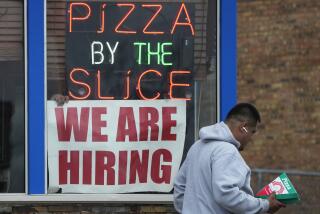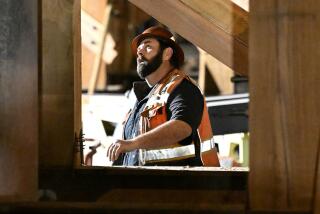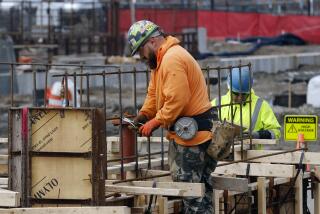Companies Avoid Hiring but Spend More : Economy: Analysts see connection between increased capital investment and stagnant employment figures.
- Share via
WASHINGTON — American businesses are spending their profits on machinery to enhance the productivity of existing workers rather than hiring more people, according to two government reports released Thursday.
Companies surveyed by the Commerce Department in April and May said they will increase investment spending on new buildings and equipment by 6.4% this year.
Such an increase would be the largest since an 11.4% rise in 1989.
Meanwhile, the Labor Department said the number of Americans filing for unemployment benefits dropped by a modest 2,000 to 345,000 last week. The number of claims has fluctuated in a narrow range between 337,000 and 347,000 over the last seven weeks, indicating little change in labor market conditions.
“One suspects there is a connection,” said economist Laurence H. Meyer, a St. Louis-based consultant. “Firms are reluctant to hire. They’re trying to trim the number of workers. In order to produce with fewer workers, they need different equipment.”
The Labor Department said the four-week moving average of new claims, regarded by economists as a more accurate barometer of the labor market than the more volatile weekly figure, stood at 342,750 last week, up from 340,750 a week earlier.
“These figures point to the continuation of a trend that we’ve been seeing of modest improvement in the labor market,” said Kevin Flanagan, an economist at Dean Witter.
In a separate development, the White House revealed that President Clinton and Federal Reserve Board Chairman Alan Greenspan met for about an hour Wednesday night.
Many economists have speculated that the central bank is prepared to nudge short-term interest rates higher if government reports continue to show stepped-up inflation this year.
But White House Press Secretary Dee Dee Myers said, “Most of the . . . economic advisers here believe there is no real inflationary pressure in the economy.”
Businesses told the government they will spend $581 billion in 1993 constructing and modernizing buildings, installing new computers and upgrading and replacing other equipment and machinery.
In 1992, businesses’ capital spending totaled $546 billion, a 3.3% increase over 1991, a recession year, when spending posted a rare decline of 0.8%.
The latest survey on 1993 plans represents a modest reduction from the 6.6% increase planned when the department surveyed businesses in the first quarter.
Economist Lynn Reaser of First Interstate Bancorp of Los Angeles said it is a positive sign that the plans are so little changed after Clinton abandoned his proposal for an investment tax credit.
“The underlying support for capital spending is coming from good gains in profits . . . and low interest rates,” she said.
At the same time, uncertainty over health care costs and Clinton Administration tax proposals has discouraged businesses from putting their profits into expanded payrolls, she said.
In fact, equipment spending is one of the few bright spots in an otherwise sluggish economy. In the first quarter, it increased at a seasonally adjusted annual rate of 16.5%, the best gain of any major sector within the gross domestic product.
“The private sector is expanding capacity at a steady rate and . . . is prepared to invest if the environment is right,” Commerce Secretary Ronald H. Brown said in a statement issued from France, where he was attending the Paris Air Show.
Part of the proper environment, he said, would be swift Senate passage of a budget package achieving Clinton’s goals for reducing the budget deficit.
Brown’s department offered these details on capital spending:
* Manufacturers said they plan a 2.5% increase in investment this year, scaled back from a first-quarter estimate of 5.4%.
* Manufacturers of durable goods, big-ticket items lasting three or more years, plan a 5.6% increase, while makers of non-durable goods plan only a 0.2% rise.
* Non-manufacturing firms project an 8.3% increase.
* Among the industries with the biggest plans are stone, clay and glass manufacturing, up 29.3%; auto and truck manufacturing, up 16.6%, and electrical machinery manufacturing, up 14%.
* The worst projected declines are in aircraft manufacturing, down 25.1%; airlines, down 16.4%, and rubber manufacturing, down 15.1%.
Overall, U.S. firms plan an inflation-adjusted rise in investment spending of 9.1% this year, the largest since a 15.8% increase in 1984.
More to Read
Inside the business of entertainment
The Wide Shot brings you news, analysis and insights on everything from streaming wars to production — and what it all means for the future.
You may occasionally receive promotional content from the Los Angeles Times.










